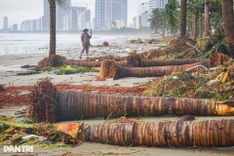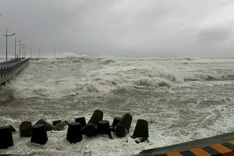
REUTERS/Yomiuri
Self-Defense Force officers search for missing people by a boat after a tsunami and earthquake in Souma City in Fukushima Prefecture March 12, 2011.
A third explosion in four days rocked a crippled nuclear power plant in tsunami-ravaged northeastern Japan early Tuesday as authorities struggled to avert a catastrophic release of radiation.
The cascading troubles at the Fukushima Dai-ichi complex were set in motion when last Friday\'s quake and tsunami knocked out power, crippling the cooling systems needed to keep nuclear fuel from going into full meltdown.
The latest blast happened in the plant\'s Unit 2 near a suppression pool, which removes heat under a reactor vessel, plant owner Tokyo Electric Power Co. said. No one was reported injured, but plant workers were temporarily evacuated.
Japanese officials said radiation levels at the plant are within safe limits, and international scientists said that while there are serious dangers, there is little risk of a catastrophe like the deadly 1986 blast in Chernobyl in Ukraine, where there were no containment shells to hold back the radiation.
Japanese authorities have been injecting seawater as a coolant of last resort, and advising nearby residents to stay inside to avoid contamination.
"It\'s like a horror movie," said 49-year-old Kyoko Nambu as she stood on a hillside overlooking her ruined hometown of Soma, about 25 miles (40 kilometers) from the plant. "Our house is gone and now they are telling us to stay indoors.
"We can see the damage to our houses, but radiation? ... We have no idea what is happening. I am so scared."
The accidents injured 15 workers and military personnel and exposed up to 190 people to elevated radiation.
That compounded challenges already faced by the Tokyo government as it dealt with twin disasters that flattened entire communities and left as many as 10,000 or more dead.
It also raised global concerns about the safety of nuclear power at a time when it has seen a resurgence as an alternative to fossil fuels.
Japanese authorities said that there have been no large-scale radiation releases, though they had detected temporary elevations of radiation. Tens of thousands of people around affected reactors were evacuated.
Prevailing winds were pointing out to sea, and U.S. ships assisting tsunami recovery moved further way to avoid potential danger.
A top Japanese official said the fuel rods in all three of the operational reactors at the Fukushima Dai-ichi plant appeared to be melting.
"Although we cannot directly check it, it\'s highly likely happening," Chief Cabinet Secretary Yukio Edano told reporters.
There were few details immediately available about Tuesday\'s blast.
It followed a hydrogen explosion Monday at the plant\'s Unit 3 reactor that injured seven workers and four members of the defense forces. A similar blast Saturday at Unit 1 injured four people. Authorities said that neither of the earlier blasts compromised the inner containment layers around the reactors, and that they were most concerned with low water levels at Unit 2.
The water levels twice dropped enough to expose fuel rods in the reactor. They were restored but were falling again, increasing the risk of a worst-case scenario involving a full meltdown with the uranium core eating through the reactor\'s steel-reinforced containment vessel and causing a widespread release of dangerous radiation.
A pressure release valve for Unit 2\'s reactor containment vessel was failing to open, hindering efforts to keep water flowing into the chamber, nuclear agency official Naoki Kumagai said. He said officials considered spraying water directly over the steel-reinforced chamber.
The head of the International Atomic Energy Agency said the Japanese goverment has asked the agency to send experts to help.
"Units 1 and 3 are at least somewhat stabilized for the time being," said Nuclear and Industrial Safety Agency official Ryohei Shiomi. "Unit 2 now requires all our effort and attention."
The blast Monday at Unit 3 actually lessened pressure building inside that troubled reactor, and officials said the all-important containment shell — thick concrete armor around the reactor — had not been damaged. In addition, officials said radiation levels remained within legal limits, though anyone left within 12 miles (20 kilometers) of the scene was ordered to remain indoors.
"We have no evidence of harmful radiation exposure," deputy Cabinet secretary Noriyuki Shikata told reporters.
It was not immediately clear if Tuesday\'s explosion meant a similar release of pressure inside Unit 2.
Outside experts were trying to piece together the level of risk based on the limited public pronouncements so far by Japanese officials. While scientists said the situation was serious, it didn\'t seem to be careening toward Chernobyl-like total meltdown.
The reactor that exploded at Chernobyl, which sent a cloud of radiation over much of Europe and was blamed directly for nearly 50 deaths, was not housed in a sealed container as those at Dai-ichi are.
But Donald Olander, professor emeritus of nuclear engineering at the University of California at Berkeley, said having uranium fuel rods exposed was a crucial problem. Water is what keeps them from getting too hot, and melting the uranium fuel pellets inside.
He calculated that each of the three reactors at risk probably require 50 gallons (190 liters) a minute of new water being pumped in to cool down the enormous heat involved.
The more time that passes with the reactor containment vessels intact, the less the chance of a catastrophe because "nuclear decay" lessens some of the enormous heat in the reactor, said James Stubbins, head of nuclear engineering at University of Illinois.
"They\'re doing a good job of containing what might be melting," Stubbins said.
The Dai-ichi plant is the most severely affected of three nuclear complexes that were declared emergencies after suffering damage in Friday\'s quake and tsunami, raising questions about the safety of such plants in coastal areas near fault lines and adding to global jitters over the industry.
Switzerland ordered a freeze on new plants, while Germany said it was suspending a decision to extend the life of its nuclear plants. The United States said it would try to learn from the Japanese crisis but that events would not diminish the U.S. commitment to nuclear power.
"When we talk about reaching a clean energy standard, it is a vital part of that," White House spokesman Jay Carney said.
The hydrogen explosions at the Dai-ichi plant\'s Unit 1 and Unit 3 were sparked when operators vented steam containing hydrogen to relieve pressure in the containment vessels.
Operators knew that would potentially lead to an explosion — but felt they had no choice if they wanted to avoid complete meltdowns. Eventually, hydrogen in the released steam mixed with oxygen in the atmosphere and set off the two blasts.
Japan\'s meteorological agency reported one good sign. It said the prevailing wind in the area of the stricken plant was heading east into the Pacific, which would help carry away any radiation.
Meanwhile, 17 U.S. military personnel involved in helicopter relief missions were found to have been exposed to low levels of radiation after they flew back from the devastated coast to the USS Ronald Reagan, an aircraft carrier about 100 miles (160 kilometers) offshore.
U.S. officials said the exposure level was roughly equal to one month\'s normal exposure to natural background radiation, and the 17 were declared contamination-free after scrubbing with soap and water.
As a precaution, the carrier and other 7th Fleet ships involved in relief efforts had shifted to another area, the U.S. said.




















